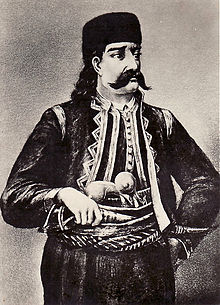Stanoje Glavaš
| Stanoje Glavaš | |
|---|---|

Illustration by Đura Jakšić
|
|
| Born | 21 February 1763 Smederevska Palanka, Ottoman Empire (modern Serbia) |
| Died | 25 February 1815 Ottoman Empire (modern Serbia) |
| Allegiance |
|
| Years of service | 1790s—1815 |
| Battles/wars |
|
Stanoje Stamatović (Serbian Cyrillic: Станоје Стаматовић), known as Stanoje Glavaš (Станоје Главаш; 21 February 1763 – 25 February 1815) was a Serbian hajduk and hero in the First Serbian Uprising.
Glavaš was born in 1763 in the village of Glibovac, near Smederevska Palanka, at the time part of the Sanjak of Smederevo, Ottoman Empire. In his youth, he was a gentleman's tailor in Smederevska Palanka. He never married, which was unusual for small town business owners of the time in Serbia. For a time, he shared a house with a certain other confirmed bachelor, originally from Negotin, one Borisav Petrović, and they had a joint entreprise for constructing adobe houses. During this time Karađorđe Petrović spent several months in Glavaš's house, either as an apprentice or as a hajduk in hiding during wintertime.
Later, Glavaš was the co-leader, with and , of a hajduk company based in Austrian-held Syrmia, which frequently crossed the Ottoman border, and attacked Ottoman forces and caravans in the Sanjak of Smederevo in the 1790s (including Koča's frontier rebellion).
In 1804, at the eve of the First Serbian Uprising, Glavaš, Karađorđe and several other leaders gathered at Orašac to organize the revolt (see Serbian Revolution). Glava[ was suggested as leader. He refused the offer, opting for Karađorđe instead. In December 1806, commanders Vujica, Mladen Milovanović and Glavaš commanded an army of 18,000 soldiers to defend the Serbs at the Battle of Deligrad. The fight ended in Serbian victory, with Ibrahim Bushati, pasha of Shkodër, signing a 6-week truce. He led a company of around 3,000 men which liberated Prokuplje and Kuršumlija. His company guarded the Morava Valley and fought the Ottomans in the mountains of Niš and Novi Pazar for two months before being captured. He was killed by the Ottomans on 25 February 1815, after the demise of Hadži-Prodan's Uprising. His severed head was on display at the Kalemegdan along with other Serbian leaders.
...
Wikipedia
